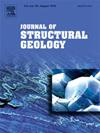Boundary curvature as a first-order control on strain localization in arcuate shear zone: Insights from field observations, analogue and numerical modelling
IF 2.9
2区 地球科学
Q2 GEOSCIENCES, MULTIDISCIPLINARY
引用次数: 0
Abstract
Curved shear zones are common in orogenic systems, yet the role of boundary curvature in governing strain localization remains underexplored. Using the Singhbhum Shear Zone (SSZ) in eastern India as a natural analogue, we develop an integrated approach combining analytical Couette flow theory, physical analogue modelling with Newtonian viscous Polydimethylsiloxane (PDMS), and finite element simulations. The results consistently reveal a non-monotonic velocity profile with a neutral radius where flow reverses direction, creating distinct zones of localized shear. Strain markers in the experiment deform most intensely near the inner arc and progressively less outward, mirroring field evidence from the SSZ, where high-strain mylonites and strong non-cylindrical folds transition into overprinting crenulations and open folds. This convergence between model predictions and field observations demonstrates that the boundary curvature alone, absent of mechanical or lithological heterogeneity can explain strain partitioning, flow reversal, and fold overprinting in a ductile regime. The study provides a transferable kinematic framework for interpreting curved tectonic interfaces and underscores the often-underestimated role of geometry in shaping deformation. (Words: 168)
边界曲率作为弓形剪切带应变局部化的一阶控制:来自现场观测、模拟和数值模拟的见解
弯曲剪切带在造山带中很常见,但边界曲率在控制应变局部化中的作用尚未得到充分探讨。利用印度东部的Singhbhum剪切带(SSZ)作为自然模拟,我们开发了一种综合方法,将分析库埃特流理论、牛顿粘性聚二甲基硅氧烷(PDMS)物理模拟建模和有限元模拟相结合。结果一致显示出一个非单调的速度剖面,具有中性半径,其中流动方向相反,形成明显的局部剪切区。实验中的应变标记在靠近内弧处变形最强烈,向外逐渐减弱,反映了来自SSZ的现场证据,在那里,高应变糜棱岩和强非圆柱形褶皱转变为套印纹纹和开放褶皱。模型预测和现场观测之间的这种收敛表明,在没有力学或岩性非均质性的情况下,仅边界曲率就可以解释韧性状态下的应变分配、流动逆转和褶皱叠加。该研究为解释弯曲的构造界面提供了一个可转移的运动学框架,并强调了几何在塑造变形中的作用往往被低估。(单词:168)
本文章由计算机程序翻译,如有差异,请以英文原文为准。
求助全文
约1分钟内获得全文
求助全文
来源期刊

Journal of Structural Geology
地学-地球科学综合
CiteScore
6.00
自引率
19.40%
发文量
192
审稿时长
15.7 weeks
期刊介绍:
The Journal of Structural Geology publishes process-oriented investigations about structural geology using appropriate combinations of analog and digital field data, seismic reflection data, satellite-derived data, geometric analysis, kinematic analysis, laboratory experiments, computer visualizations, and analogue or numerical modelling on all scales. Contributions are encouraged to draw perspectives from rheology, rock mechanics, geophysics,metamorphism, sedimentology, petroleum geology, economic geology, geodynamics, planetary geology, tectonics and neotectonics to provide a more powerful understanding of deformation processes and systems. Given the visual nature of the discipline, supplementary materials that portray the data and analysis in 3-D or quasi 3-D manners, including the use of videos, and/or graphical abstracts can significantly strengthen the impact of contributions.
 求助内容:
求助内容: 应助结果提醒方式:
应助结果提醒方式:


